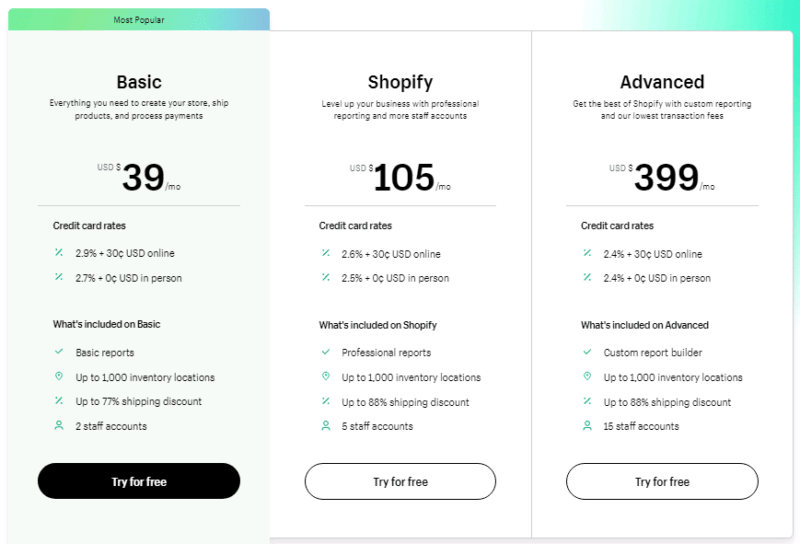My content is reader-supported by awesome people like you. Which means I could earn a commission. Learn more here!
Choosing the right platform to sell your products online can be overwhelming.
Shopify and eBay both offer powerful features, but they cater to different needs, and making the wrong choice could mean missing out on revenue or spending more time managing your store than actually growing it.
If you choose the wrong platform, you risk losing control over your branding, facing unexpected fees, or not reaching the right customers.
Worse yet, you could end up locked into a platform that doesn’t align with your business goals.
But don’t worry!
In this post, we’ll break down the critical differences between Shopify vs eBay so you can make the smartest decision for your business.
From pricing models to ease of use and customer support, we’ve got you covered.
Keep reading to find out which platform truly fits your business needs!
Shopify Vs eBay Summary
| Feature | Shopify | eBay |
|---|---|---|
| Ease of Use | User-friendly with intuitive drag-and-drop interface for building online stores. | Straightforward for listing products, but the platform is geared more towards auctions. |
| Target Audience | Businesses and entrepreneurs aiming to create their own online store. | Individuals or small businesses looking to sell products through an auction or fixed price listings. |
| Product Control | Complete control over branding, store design, and product offerings. | Limited control over branding, as products are listed in eBay’s marketplace. |
| Sales Model | Fixed-price model with the option for discounts, subscriptions, and recurring sales. | Auction-based sales with the option for fixed-price listings. |
| Fees | Monthly subscription fees, plus transaction fees on each sale. | Listing fees, final value fees, and PayPal transaction fees per sale. |
| Customization | High customization options for store design, themes, and features. | Minimal customization for store layout and design. |
| Payment Options | Multiple payment gateways including Shopify Payments, PayPal, and others. | PayPal and credit card payments via eBay’s integrated system. |
| Marketing Tools | Advanced marketing tools including SEO, email campaigns, ads, and social media integrations. | Basic marketing options, mainly relying on eBay’s internal search and promotions. |
| Customer Support | 24/7 support with live chat, email, and phone options. | Limited support with a focus on self-service resources, although eBay does offer help for disputes. |
| Best For | Entrepreneurs and businesses building a brand with full control over the store experience. | Casual sellers, small businesses, or those looking to quickly list products without creating a full website. |
Ease of Use
Shopify is generally considered to have better ease of use compared to eBay.
The Shopify platform is very intuitive and user-friendly, allowing sellers to easily create and customize their online stores with various themes, templates and apps.
Shopify makes it simple to manage products, inventory, orders, shipping, and payments all in one dashboard.
The admin area and store editor have a gentle learning curve even for those without much technical expertise.
In contrast, eBay can be more overwhelming for new users.
The platform is primarily designed around product listings and auctions rather than full eCommerce storefronts.
While eBay does offer some customization of seller profiles, the options are more limited compared to Shopify stores.
eBay sellers need to juggle product listings across multiple areas like eBay shops, auction-style listings, and Buy It Now listings.
The interface can be busier and more complex to navigate.
Overall, Shopify provides a more streamlined, customizable experience for eCommerce merchants.
The intuitive store setup and management make Shopify easier to use for beginners as well as experienced online sellers.
eBay is better suited for established sellers accustomed to the auction model, but Shopify simplifies the process for anyone looking to create an independent brand online.
Overall I’d say these two tie for ease of use because you are going to have a learning curve regardless.
Design
Shopify offers a much more modern and customizable design experience compared to eBay.
Shopify has over 100 free and paid themes to choose from, with options like debut, venture, and Brooklyn giving your store a visually appealing look right out of the box.
The themes are also highly customizable, allowing you to tweak things like fonts, colors, and layouts to create a unique brand identity.
eBay’s design options are far more limited, with only a handful of basic templates to choose from.
While eBay themes work, they lack the polish and customizability of Shopify.
For those who want a modern, branded eCommerce store, Shopify is the clear winner when it comes to design and themes.
The customization options give merchants much more control over the look and feel of their online store.
Performance
Shopify and eBay have very different approaches when it comes to website performance.
As an eCommerce platform, Shopify is optimized for fast page load speeds and provides tools to help merchants improve conversions.
In testing, Shopify stores averaged page load speeds under one second, which is excellent for eCommerce sites.
Shopify builds performance into its core platform and CDN.
In contrast, eBay is a marketplace with varying seller stores and product pages.
Load speeds can vary more from seller to seller.
Overall, eBay product pages tend to have slower load times compared to Shopify stores.
This is likely due to having less control over optimizations as an individual eBay seller.
Shopify’s platform-level performance wins over eBay in this area.
Faster page speeds lead to better conversion rates and lower bounce rates.
So Shopify’s focus on performance gives it an edge for store owners who want reliable site speed.
With Shopify, you don’t have to worry as much about technical optimizations, as it’s handled at the platform level.
Pricing & Fees
When it comes to pricing, Shopify and eBay have very different business models.
Shopify operates on a subscription-based model, charging sellers a monthly fee to access their platform and tools.
Shopify has four main pricing tiers ranging from $29/month to $299/month, with additional costs for payment processing, shipping labels, and other add-ons.
According to Getshogun, Shopify doesn’t charge any listing fees, so sellers can list as many products as they want for their monthly fee.
eBay, on the other hand, makes most of its revenue through seller fees.
eBay charges both monthly store fees and per-item listing fees.
Their basic store starts at $4.95/month, going up to $2,999.95/month for an enterprise store store.
On top of that, eBay charges start at $.30 to list an item and up to 10% of the final sale price as a final value fee.
While experienced eBay sellers can find ways to reduce fees, their fee structure ultimately takes a larger cut of sales compared to Shopify’s predictable subscriptions.
When evaluating pricing, sellers should calculate their expected sales volume and revenue to determine if Shopify or eBay fees offer a better value.
I find Shopify way more cut and dry personally than eBay due to the fact of all the tiers on ebay.
I think they could make this way easier and less complicated.
Once you get it down sure you will understand better but man it’s a lot.
Payments
When it comes to payments, Shopify and eBay take different approaches.
Shopify has built-in payment processing through Shopify Payments.
This allows you to accept credit cards without needing a third-party provider.
Shopify Payments has competitive transaction fees starting at 2.9% + 30¢ per transaction.
It also offers a virtual terminal and POS hardware integration.
The integrated payments help streamline checkout and let you manage everything in one place.
eBay, on the other hand, requires using PayPal for processing payments.
PayPal charges a 2.9% transaction fee plus a fixed fee based on currency.
This means you need to manage payments separately from your eBay sales.
However, many buyers have PayPal accounts already, which can help with conversion.
Overall, Shopify Payments offers a more unified and convenient payment experience.
But eBay’s large buyer base and PayPal’s familiarity can also be advantages.
The choice comes down to your preferences for integration versus reach.
Support
eBay’s support options are more limited compared to Shopify.
eBay primarily offers support through its help center, which contains articles and FAQs to address common issues.
However, response times can be slow if you need to submit a ticket.
In contrast, Shopify provides 24/7 support through live chat, phone, and email.
You can typically get an immediate response via Shopify’s chat support, which is extremely helpful for time-sensitive issues.
Shopify also offers a vibrant community forum where you can crowdsource answers from other Shopify merchants.
Overall, Shopify’s superior support gives merchants much-needed peace of mind, especially when first getting started.
Having quick access to support can help you resolve technical problems faster and minimize downtime for your store.
Marketing
Shopify provides more sophisticated and robust marketing tools compared to eBay, which allows merchants to promote their brands and products more effectively.
Some key differences in marketing capabilities:
-
Shopify SEO: Shopify has built-in SEO features like alt text optimization and rich snippets to help merchants improve their search engine rankings. Shopify also integrates with SEO apps like Yoast to further optimize on-page SEO. eBay has minimal SEO capabilities in comparison.
-
Abandoned carts: Shopify sends automated abandoned cart emails to recover sales. Their platform also integrates with apps to offer SMS and Facebook retargeting for abandoned carts. eBay doesn’t provide automated abandoned cart capabilities.
-
Email marketing: Shopify offers an email marketing app to create campaigns, collect subscribers, and track performance. eBay doesn’t have native email marketing.
-
Discount capabilities: Shopify has robust discount features like percentage discounts, BOGO sales, and free shipping offers. eBay only supports item-specific discounting.
-
Blogging: Shopify allows merchants to run a blog to increase organic traffic and promote products. eBay doesn’t support blogging.
The much wider range of marketing tools gives Shopify merchants a significant advantage in promoting their online stores and driving sales.
eBay sellers have access to a limited set of marketing features in comparison.
FAQ For Shopify VS eBay
What’s the difference between Shopify and eBay?
Consider Shopify as your own private online shop, where you control your branding, product presentation, and overall user experience. It’s like managing a boutique, where you get to design the entire store. On the flip side, eBay is more like a giant marketplace, filled with diverse sellers. Your store exists under eBay’s umbrella brand, and your products are just one in a sea of many. But hey, eBay’s size also means instant visibility amongst an established audience, so think about what’s more important: control or reach?
Is eBay more cost-effective than Shopify?
It’s not one-size-fits-all. eBay charges fees per listing and a percentage of the final sale price. Shopify, though, has monthly subscription plans. With Shopify, you get added features like a custom domain, website builder, and 24/7 support, hence, it might lead to a higher initial cost. But remember, an adjective like “cost-effective” is subjective—what’s valuable to one person might not be to another.
Can I integrate Shopify with eBay?
The answer is yes! Shopify offers a nifty built-in eBay sales channel option, allowing you to manage your eBay listings right from your Shopify hub. It’s like having your cake and, well, another slice of cake!
How’s the analytical support on Shopify vs eBay?
Metrics matter, right? Shopify provides detailed analytics about your sales, customer statistics, and traffic straight from your dashboard. That’s like having a personal statistician on your website! eBay, in contrast, provides a more general overview of your sales and performance. The deeper dives? They’re available, but for additional costs.
How does Shopify and eBay handle payments?
With Shopify, you have the liberty of using a number of payment gateways, including Shopify Payments (powered by Stripe), PayPal, Amazon Pay, and others. eBay, however, primarily uses PayPal for transactions, providing a familiar and trusted platform for many customers.
Conclusion On Shopify Vs eBay
In this analysis and comparison, we evaluated Shopify and eBay, two of the leading players in the eCommerce platform market.
After taking a deep dive into key factors like ease of use, design, performance, pricing, and customer support, it’s clear that both platforms have merits and downsides depending on the needs of each online seller.
Shopify shines for its all-in-one solution with integrated payment processing and a vast library of themes, while eBay is better suited for established sellers who already have inventory and want to tap into eBay’s massive buyer base.
For new sellers just starting out, Shopify does offer a more guided, newbie-friendly onboarding process.
The platform makes it easy to quickly launch a good-looking, professional online store.
Shopify also provides robust analytics and marketing capabilities to help merchants promote their brand.
However, Shopify’s monthly subscription fees can add up, especially at higher tiers.
The transaction fees on top of payment processing costs can also cut into profit margins.
eBay offers more flexibility with various selling formats and pricing models, though the interface isn’t as polished or intuitive as Shopify.
Ultimately, the “best” platform depends on each seller’s specific business model and goals.
eBay is likely better for established sellers with existing inventory who want quick exposure to buyers.
Shopify may appeal more to new entrepreneurs launching a brand from scratch.
No matter which platform you choose, the keys to eCommerce success remain the same – focus on competitive pricing, stellar customer service, and effective marketing to drive traffic and conversions.
With smart strategy and execution, both Shopify and eBay offer viable paths to building a thriving online business .
You may even find these two work great together 😉








Leave a Reply